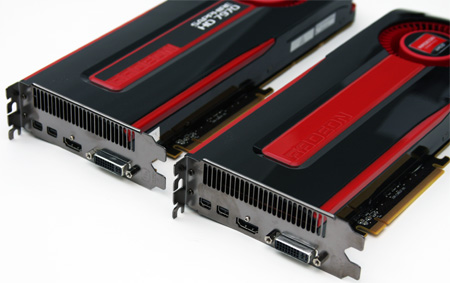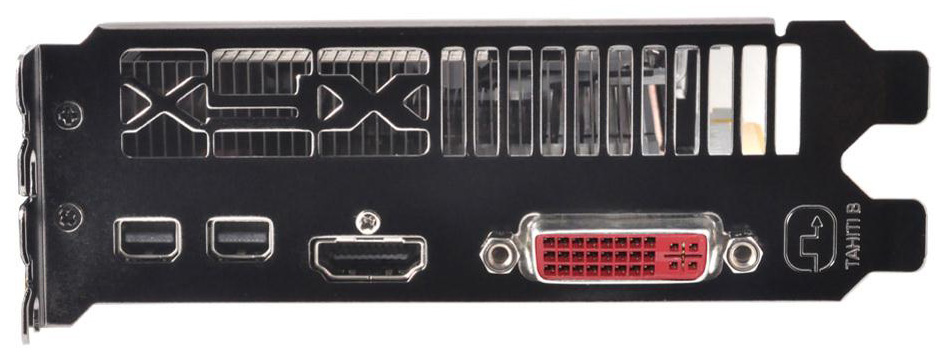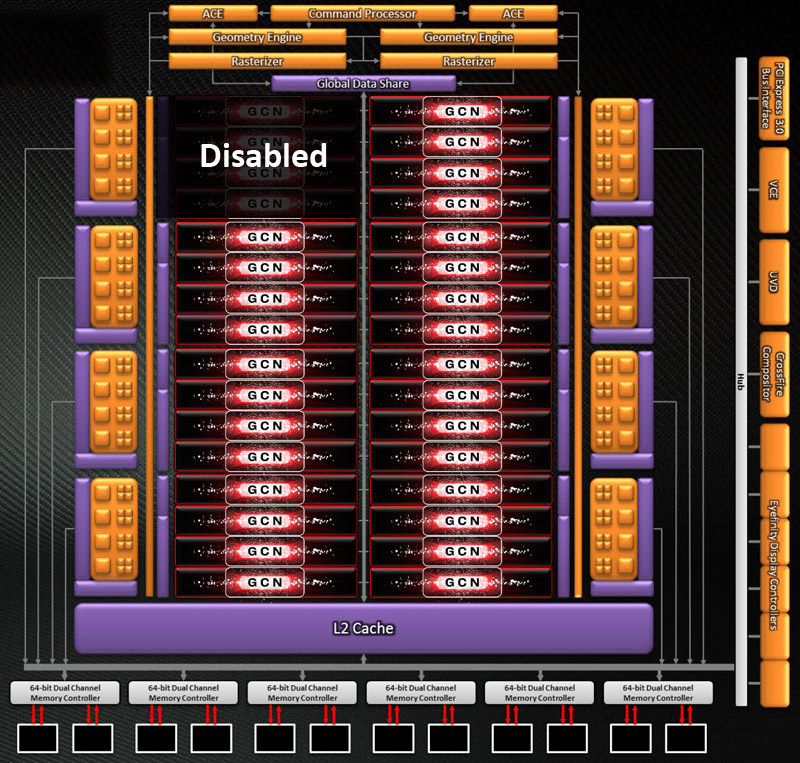AMD Radeon HD 7950 Review: Up Against GeForce GTX 580
AMD's Tahiti Pro Goes Heads-Up With Nvidia's GF110
When the Radeon HD 7970 launched at $550, it looked like a reasonable alternative to the GeForce GTX 590 and Radeon HD 6990. Both dual-GPU boards are measurably faster, but they’re also $700+, power-hungry, and in the case of the 6990, embarrassingly loud. Even still, the 7970's asking price is still pretty steep.
And that’s why a card like the Radeon HD 7950 is such a welcome addition to AMD’s portfolio. The company is, as of this writing, unwilling to comment on the 7950’s anticipated price tag. However, we’ve already run the benchmarks. We know how it stacks up to the Radeon HD 7970 and GeForce GTX 580. So, we know what we’d pay for this new board. If our target is close, we’d be looking for something under $500—perhaps $480 or $490.
What makes the Radeon HD 7950 worth a few bucks more than Nvidia's GeForce GTX 580? Well, let’s have a closer look at the card itself…
Update: Before publication, but after our launch coverage was finalized for international translation, AMD let us know that the Radeon HD 7950 should sell for $450. That's well below where I thought the company would target, given its competition. Clearly, AMD is pricing the 7950 to out-value Nvidia's GeForce GTX 580 (or force its competitor to adjust downward) rather than exist in a price structure defined by the company's single-GPU flagship. Advantage: AMD.
That's a Radeon HD 7970 up top and a Radeon HD 7950 down below. In the right light, they'd pass as twins.
Meet AMD’s Radeon HD 7950
Physically, the Radeon HD 7950 is identical to AMD’s already-available Radeon HD 7970—save one distinguishing feature: a second six-pin auxiliary power connector. That’s a telltale indication of a sub-225 W maximum board power (75 W from the slot, plus up to 75 W from each plug). In fact, AMD rates the 7950 right at 200 W. In comparison, the Radeon HD 7970’s power ceiling is 250 W, necessitating its eight- and six-pin power connectors.
Get Tom's Hardware's best news and in-depth reviews, straight to your inbox.
A 10.5” PCB is extended out an additional half of an inch by a metal base plate and plastic shroud. So, plan accordingly when you pick a chassis. This card is fairly long.
As with the Radeon HD 7970, AMD employs a centrifugal fan mounted on one end of the Radeon HD 7950, which blows across the length of the card and exhausts heated air out the back of your chassis. This is the design we prefer. It wasn’t possible to cool the Radeon HD 6990 or GeForce GTX 590 the same way. In both examples, a center-mounted fan exhausted some air from a rear I/O slot and everything else was recirculated.
Because it relies on effective exhaust, one of the card’s two slots is grated for unrestricted air flow. The other slot is populated with four display outputs: one dual-link DVI connector, one full-sized HDMI port, and a pair of mini-DisplayPort outputs.
Board partners will almost certainly bundle a variety of adapters, so be sure you’re getting the components you need before making a purchase. The two Sapphire Radeon HD 7970s we bought came with DVI-to-VGA, mini-DisplayPort-to-DisplayPort, mini-DisplayPort-to-single-link DVI, and HDMI-to-DVI adapters. Meanwhile, the XFX R7950 Black Edition card we received only included an HDMI-to-DVI adapter.
More notable, though, is that all four outputs can be active at the same time, supporting extensive display configurations that you simply cannot achieve on a single Nvidia-based board.
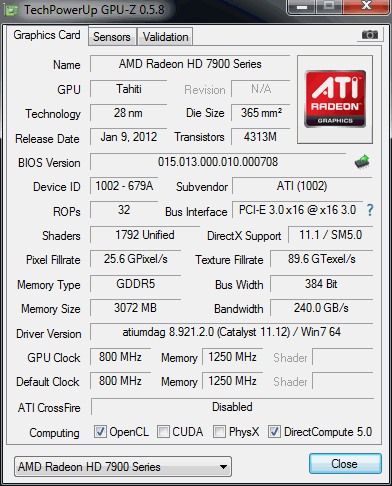
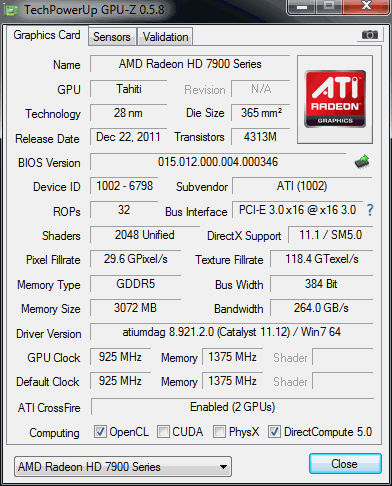
Tahiti Pro: Same GPU, But On A Diet
Radeon HD 7950 centers on the same 4.31 billion-transistor Tahiti GPU as AMD’s faster, more expensive flagship, manufactured on TSMC’s 28 nm node.
However, instead of sporting 32 Compute Units, this scaled-back model comes equipped with 28 Compute Units. As you know, each CU plays host to four Vector Units, each with 16 shaders, ALUs, Stream Processors, or whatever else you’d like to call them. That’s a total of 64 SPs per CU. A quick little multiplication (64*28) gives you a grand total of 1792 SPs on this chip.
And because each of those four missing CUs also included four texture units, that specification drops from 128 to 112.
To help differentiate the Radeon HD 7950 even further, AMD dials back its core clock rate to 800 MHz (down from 925 MHz on the reference Radeon HD 7970). Peak compute performance correspondingly drops to 2.87 TFLOPS from 3.79 TFLOPS.
The render back-ends are independent of the CUs, and AMD leaves all eight ROP partitions enabled, yielding up to 32 raster operations per clock cycle. Six 64-bit memory controllers feed the partitions through a crossbar. An aggregate 384-bit data path populated with 3 GB of GDDR5 memory operating at 1250 MHz adds up to 240 GB/s of bandwidth. That’s a slight drop from the Radeon HD 7970’s 264 GB/s, but still a very substantial increase over the Radeon HD 6970.
| Header Cell - Column 0 | Radeon HD 7950 | Radeon HD 7970 | Radeon HD 6970 | GeForce GTX 580 |
|---|---|---|---|---|
| Stream processors | 1792 | 2048 | 1536 | 512 |
| Texture Units | 112 | 128 | 96 | 64 |
| Full Color ROPs | 32 | 32 | 32 | 48 |
| Graphics Clock | 800 MHz | 925 MHz | 880 MHz | 772 MHz |
| Texture Fillrate | 89.6 Gtex/s | 118.4 Gtex/s | 84.5 Gtex/s | 49.4 Gtex/s |
| Memory Clock | 1250 MHz | 1375 MHz | 1375 MHz | 1002 MHz |
| Memory Bus | 384-bit | 384-bit | 256-bit | 384-bit |
| Memory Bandwidth | 240 GB/s | 264 GB/s | 160 GB/s | 192.4 GB/s |
| Graphics RAM | 3 GB GDDR5 | 3 GB GDDR5 | 2 GB GDDR5 | 1.5 GB GDDR5 |
| Die Size | 365 mm2 | 365 mm2 | 389 mm2 | 520 mm2 |
| Transistors (Billion) | 4.31 | 4.31 | 2.64 | 3 |
| Process Technology | 28 nm | 28 nm | 40 nm | 40 nm |
| Power Connectors | 2 x 6-pin | 1 x 8-pin, 1 x 6-pin | 1 x 8-pin, 1 x 6-pin | 1 x 8-pin, 1 x 6-pin |
| Maximum Power | 200 W | 250 W | 250 W | 244 W |
| Price (Street) | Row 14 - Cell 1 | $549 | ~$350 | ~$480 |
Current page: AMD's Tahiti Pro Goes Heads-Up With Nvidia's GF110
Next Page Tessellation Performance And Audio Output